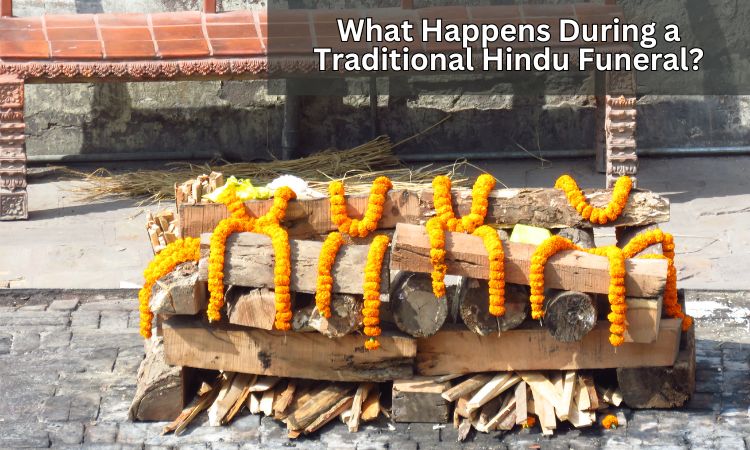Death is not seen as an end in Hinduism but rather as a transition — the soul leaving its physical form to continue its journey toward moksha (liberation). A traditional Hindu funeral is a sacred ritual that helps guide the departed soul with dignity and respect, while also offering closure and peace to the grieving family.
At Antim Journey, we understand that losing a loved one is an emotional and overwhelming experience. That’s why we are committed to supporting families through this delicate time, helping them navigate the deeply spiritual process of a traditional Hindu funeral with care, clarity, and compassion.
So, what happens during a traditional Hindu funeral? Let’s go over each step of this ageless ritual.
- Preparing the Body (Antyeshti Ritual Begins)
The funeral rites, known as Antyeshti (meaning “last rites”), begin shortly after a person has passed away. Traditionally, the body is bathed, often by close family members, using water mixed with Ganga jal (holy water from the River Ganges), rose water, and sandalwood paste. This is a symbolic purification of the physical body.
The deceased is then dressed in simple, traditional clothing — usually white for men and married women, and red or bridal attire for unmarried women. The body is adorned with fresh flowers and sacred ash or sandalwood paste is applied to the forehead.
At Antim Journey, we respectfully assist families in these sensitive rituals, offering ceremonial clothing, flowers, and purification services as needed.
- Setting the Corpse on the Arthi Bier
Once prepared, the body is placed on a wooden stretcher or bier called arthi. The head is oriented toward the south, which is Yama’s (the death god’s) orientation. Family and friends gather to offer their final respects. Garlands, incense sticks, and oil lamps are placed near the body.
Male relatives (typically the eldest son) perform rituals and place tulsi leaves, rice, and coins in the mouth of the deceased, believed to be spiritual offerings to aid the soul in its journey.
- Funeral Procession to the Cremation Ground
The body is then carried in a solemn procession to the cremation ground (shamshan ghat), accompanied by chants of “Ram Naam Satya Hai” — a reminder of the eternal truth of the soul.
The primary mourner, usually the eldest son, often shaves his head as a mark of respect and mourning. At Antim Journey, we arrange transport for the deceased, the family, and necessary items required for cremation, ensuring that the transition from home to cremation site is smooth and respectful.
- Cremation Ceremony (Mukhagni)
Hindu funerals revolve around cremation, which represents the soul’s separation from the body. The body is laid out on the prepared funeral pyre. Before lighting the fire, priests chant Vedic mantras, invoking divine blessings and peace for the soul.
The act of lighting the pyre (mukhagni) is considered one of the most sacred duties, usually performed by the eldest male in the family. Beginning at the mouth, he moves around the corpse and lights the pyre. Ghee (clarified butter), camphor, and sandalwood are often added to purify the fire.
For families opting for electric cremation, the spiritual rites are still followed with equal sanctity.
At Antim Journey, we provide both traditional and electric cremation services, while ensuring all customs and rituals are honored.
- Post-Cremation Rites (Asthi Visarjan & Shraddha)
Within a few days following cremation, the ashes (asthi) are gathered and usually submerged in a sacred river, most commonly the Ganges. This ritual, known as asthi visarjan, symbolizes the final return of the physical body to the elements.
The mourning period usually lasts 13 days (Terahvin). During this time, the family refrains from celebrations, follows a simple lifestyle, and performs daily rituals to support the soul’s peaceful transition.
On the 10th or 13th day, a Shraddha ceremony is held. It includes feeding Brahmins, offering pind daan (rice balls symbolizing the soul), and performing rituals to help the soul find peace.
Antim Journey provides comprehensive support for these ceremonies, including priest arrangements, pind daan rituals, and ash immersion assistance across major spiritual locations in India.
- Annual Rituals and Remembrance
Hindus believe in honoring ancestors through annual rituals called Shraddha and Pitru Paksha. These ceremonies allow families to express gratitude, seek blessings, and ensure the ongoing peace of the departed souls.
We also offer memorial planning and yearly remembrance services at Antim Journey, so you can continue to honor your loved ones with devotion and grace.
A traditional Hindu funeral is a beautiful blend of rituals, symbolism, and spiritual philosophy, rooted in thousands of years of tradition. It is not just a farewell, but a sacred journey — one that supports both the soul of the departed and the hearts of those left behind.
At Antim Journey, we are here to walk beside you during this difficult time — to provide not just services, but empathy, guidance, and reverence for every ritual, every prayer, every moment.

